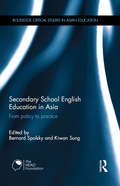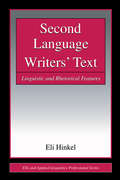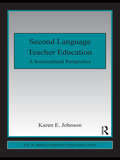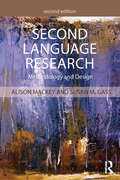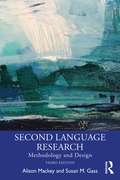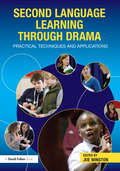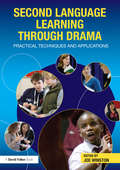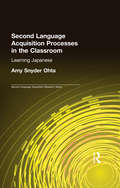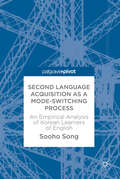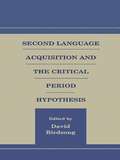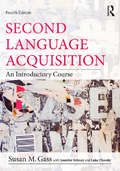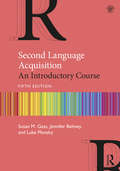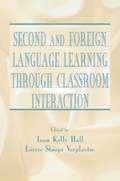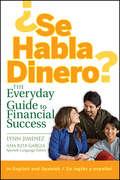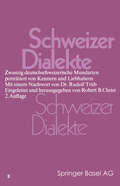- Table View
- List View
Secondary School English Education in Asia: From policy to practice (Routledge Critical Studies in Asian Education)
by Bernard Spolsky Kiwan SungContinuing on from the previously published Primary School English-Language Education in Asia: From Policy to Practice (Moon & Spolsky, 2012), this book compiles the proceedings which took place at the 2011 annual conference of AsiaTEFL which took place in Seoul, Korea. It surveys the current status, practices, challenges, and future directions of Secondary English education in 11 diverse countries - in Israel, Japan, Korea, Singapore, Bangladesh, India, Indonesia, Malaysia, Pakistan, Vietnam and China. Given the importance of secondary English education as the central feature for continuing development of target language and culture in English language teaching in Asia, each contributed chapter includes key policies, theories, and practices related to the development and implementation of country-specific curricular and instructional programs in secondary English educational contexts in these countries. Secondary School English Education in Asia: From Policy to Practice critically analyses both sides of the English language debate – from advantages to complications – in its chapters including: Educating for the 21st Century: The Singapore Experience Miles to Go …: Secondary Level English Language Education in India English Language Education Innovation for the Vietnamese Secondary School: The Project 2020 Exploring the Value of ELT as a Secondary School Subject in China: A Multi-goal Model for English Curriculum Secondary School English Education in Asia will appeal to English Language Teaching (ELT) researchers, teacher educators, trainee teachers and teachers, primarily those teaching in Asia.
Second Language Writers' Text: Linguistic and Rhetorical Features (ESL & Applied Linguistics Professional Series)
by Eli HinkelThis comprehensive and detailed analysis of second language writers' text identifies explicitly and quantifiably where their text differs from that of native speakers of English. The book is based on the results of a large-scale study of university-level native-speaker and non-native-speaker essays written in response to six prompts. Specifically, the research investigates the frequencies of uses of 68 linguistic (syntactic and lexical) and rhetorical features in essays written by advanced non-native speakers compared with those in the essays of native speakers enrolled in first-year composition courses. The selection of features for inclusion in this analysis is based on their textual functions and meanings, as identified in earlier research on English language grammar and lexis. Such analysis is valuable because it can inform the teaching of grammar and lexis, as well as discourse, and serve as a basis for second language curriculum and course design; and provide valuable insight for second language pedagogical applications of the study's findings.
Second Language Writers' Text: Linguistic and Rhetorical Features (ESL & Applied Linguistics Professional Series)
by Eli HinkelThis comprehensive and detailed analysis of second language writers' text identifies explicitly and quantifiably where their text differs from that of native speakers of English. The book is based on the results of a large-scale study of university-level native-speaker and non-native-speaker essays written in response to six prompts. Specifically, the research investigates the frequencies of uses of 68 linguistic (syntactic and lexical) and rhetorical features in essays written by advanced non-native speakers compared with those in the essays of native speakers enrolled in first-year composition courses. The selection of features for inclusion in this analysis is based on their textual functions and meanings, as identified in earlier research on English language grammar and lexis. Such analysis is valuable because it can inform the teaching of grammar and lexis, as well as discourse, and serve as a basis for second language curriculum and course design; and provide valuable insight for second language pedagogical applications of the study's findings.
Second Language Teacher Education: A Sociocultural Perspective
by Karen E. JohnsonThis book presents a comprehensive overview of the epistemological underpinnings of a sociocultural perspective on human learning and addresses in detail what this perspective has to offer the field of second language teacher education.
Second Language Teacher Education: A Sociocultural Perspective (PDF)
by Karen E. JohnsonThis book presents a comprehensive overview of the epistemological underpinnings of a sociocultural perspective on human learning and addresses in detail what this perspective has to offer the field of second language teacher education.
Second Language Teacher Education: A Sociocultural Perspective (ESL & Applied Linguistics Professional Series)
by Karen E. Johnson'… A beautifully written, articulate and compelling argument for a sociocultural perspective on second language teacher education . . . Essential reading for all who wish to understand this perspective.' – David Nunan, University of Hong Kong '…Significant and timely. Johnson is masterful at writing in an engaging, transparent prose about complex concepts. It’s a rare scholar who can write prose like this. Throughout my reading I wanted to engage in dialogue with her – this is a sure sign of a great book." – Diane Tedick, University of Minnesota, USA This book presents a comprehensive overview of the epistemological underpinnings of a sociocultural perspective on human learning and addresses in detail what this perspective has to offer the field of second language teacher education. Captured through five changing points of view, it argues that a sociocultural perspective on human learning changes the way we think about how teachers learn to teach, how teachers think about language, how teachers teach second languages, the broader social, cultural, and historical macro-structures that are ever present and ever changing in the second language teaching profession, and what constitutes second language teacher professional development. Overall, it clearly and accessibly makes the case that a sociocultural perspective on human learning reorients how the field understands and supports the professional development of second language teachers.
Second Language Teacher Education: A Sociocultural Perspective (ESL & Applied Linguistics Professional Series)
by Karen E. Johnson'… A beautifully written, articulate and compelling argument for a sociocultural perspective on second language teacher education . . . Essential reading for all who wish to understand this perspective.' – David Nunan, University of Hong Kong '…Significant and timely. Johnson is masterful at writing in an engaging, transparent prose about complex concepts. It’s a rare scholar who can write prose like this. Throughout my reading I wanted to engage in dialogue with her – this is a sure sign of a great book." – Diane Tedick, University of Minnesota, USA This book presents a comprehensive overview of the epistemological underpinnings of a sociocultural perspective on human learning and addresses in detail what this perspective has to offer the field of second language teacher education. Captured through five changing points of view, it argues that a sociocultural perspective on human learning changes the way we think about how teachers learn to teach, how teachers think about language, how teachers teach second languages, the broader social, cultural, and historical macro-structures that are ever present and ever changing in the second language teaching profession, and what constitutes second language teacher professional development. Overall, it clearly and accessibly makes the case that a sociocultural perspective on human learning reorients how the field understands and supports the professional development of second language teachers.
Second Language Research: Methodology and Design
by Alison Mackey Susan M. GassIn this second edition of the best-selling Second Language Research, Alison Mackey and Sue Gass continue to guide students step-by-step through conducting the second language research process with a clear and comprehensive overview of the core issues in second language research. Supported by a wealth of data examples from actual studies, the book examines questions of what is meant by research and what defines good research questions, covering such topics as basic research principles and data collection methods, designing a quantitative research study, and concluding and reporting research findings. The second edition includes a new chapter on mixed-methods, new "time to think" and "time to do" text boxes throughout, and updates to reflect the latest research and literature. Supplementary materials, including an extensive glossary and appendices of forms and documents that students can use in conducting their own studies, serve as useful reference tools, with suggestions on how to get research published reemphasizing the book’s practical how-to approach. Second Language Research, Second Edition is the ideal resource for understanding the second language research process for graduate students in Second Language Acquisition and Applied Linguistics.
Second Language Research: Methodology and Design
by Alison Mackey Susan M. GassIn this second edition of the best-selling Second Language Research, Alison Mackey and Sue Gass continue to guide students step-by-step through conducting the second language research process with a clear and comprehensive overview of the core issues in second language research. Supported by a wealth of data examples from actual studies, the book examines questions of what is meant by research and what defines good research questions, covering such topics as basic research principles and data collection methods, designing a quantitative research study, and concluding and reporting research findings. The second edition includes a new chapter on mixed-methods, new "time to think" and "time to do" text boxes throughout, and updates to reflect the latest research and literature. Supplementary materials, including an extensive glossary and appendices of forms and documents that students can use in conducting their own studies, serve as useful reference tools, with suggestions on how to get research published reemphasizing the book’s practical how-to approach. Second Language Research, Second Edition is the ideal resource for understanding the second language research process for graduate students in Second Language Acquisition and Applied Linguistics.
Second Language Research: Methodology and Design
by Alison Mackey Susan M. GassSecond Language Research: Methodology and Design is a clear, comprehensive overview of core issues in L2 research. Authored by well-known scholars in SLA and supported by a wealth of examples from actual studies and extensive pedagogical resources, this book first introduces students to the key topics and debates in L2 research. It then guides readers step by step through the research process—from basic principles and collection methods through study design and reporting—to the point of being able to conduct their own research from beginning to end. This book is an essential text for students and novice researchers of SLA, applied linguistics, and second and foreign language teaching. Key Features A wealth of graphics, visuals, and exercises in each chapter. "Time to Think" and "Time to Do" boxes within chapters Helpful glossary and subject index New to This Edition Substantially reorganized chapters Significantly expanded chapters on qualitative and mixed methods Substantive revised material on computer/technology-based research Spotlights a variety of new software packages and databases, including video-mediated technology and games Discusses the Open Science Movement Expanded coverage of corpora, processing, and psycholinguistics-based research Updated references throughout
Second Language Research: Methodology and Design
by Alison Mackey Susan M. GassSecond Language Research: Methodology and Design is a clear, comprehensive overview of core issues in L2 research. Authored by well-known scholars in SLA and supported by a wealth of examples from actual studies and extensive pedagogical resources, this book first introduces students to the key topics and debates in L2 research. It then guides readers step by step through the research process—from basic principles and collection methods through study design and reporting—to the point of being able to conduct their own research from beginning to end. This book is an essential text for students and novice researchers of SLA, applied linguistics, and second and foreign language teaching. Key Features A wealth of graphics, visuals, and exercises in each chapter. "Time to Think" and "Time to Do" boxes within chapters Helpful glossary and subject index New to This Edition Substantially reorganized chapters Significantly expanded chapters on qualitative and mixed methods Substantive revised material on computer/technology-based research Spotlights a variety of new software packages and databases, including video-mediated technology and games Discusses the Open Science Movement Expanded coverage of corpora, processing, and psycholinguistics-based research Updated references throughout
Second Language Learning through Drama: Practical Techniques and Applications
by Joe WinstonDrama is increasingly being recognised as a valuable pedagogy for language learning as it can harness children‘s imaginations and stimulate their desire to communicate. Second Learning Language through Drama draws on current theories of additional and foreign language learning and illustrates through practical case studies how drama can be used to support the four key skills of listening, speaking, reading and writing. Drawing on the work of an international group of practitioners who are all highly experienced in using drama for the purpose of second language learning, the book clearly explains key drama conventions and strategies and outlines the innovative ways they have been used to create enjoyable and stimulating classroom activities that allow for multiple ways of learning. Throughout the book the emphasis is on making language learning accessible and relevant to children and young people through creative, physically active and playful approaches. The strategies described are all highly flexible and readily adaptable to different teaching contexts. Specific themes include: Using stories and drama to motivate learners at all levels Drama, language learning and identity Assessment opportunities through process drama Issues of language learning and cultural empowerment Digital storytelling Film & drama aesthetics Second Language Learning through Drama will be of great interest to those studying on undergraduate and postgraduate courses and will serve as a highly valuable text to practitioners looking to incorporate the approaches described into their lessons and classroom activities.
Second Language Learning through Drama: Practical Techniques and Applications
by Joe WinstonDrama is increasingly being recognised as a valuable pedagogy for language learning as it can harness children‘s imaginations and stimulate their desire to communicate. Second Learning Language through Drama draws on current theories of additional and foreign language learning and illustrates through practical case studies how drama can be used to support the four key skills of listening, speaking, reading and writing. Drawing on the work of an international group of practitioners who are all highly experienced in using drama for the purpose of second language learning, the book clearly explains key drama conventions and strategies and outlines the innovative ways they have been used to create enjoyable and stimulating classroom activities that allow for multiple ways of learning. Throughout the book the emphasis is on making language learning accessible and relevant to children and young people through creative, physically active and playful approaches. The strategies described are all highly flexible and readily adaptable to different teaching contexts. Specific themes include: Using stories and drama to motivate learners at all levels Drama, language learning and identity Assessment opportunities through process drama Issues of language learning and cultural empowerment Digital storytelling Film & drama aesthetics Second Language Learning through Drama will be of great interest to those studying on undergraduate and postgraduate courses and will serve as a highly valuable text to practitioners looking to incorporate the approaches described into their lessons and classroom activities.
Second Language Acquisition Processes in the Classroom: Learning Japanese (Second Language Acquisition Research Series)
by Amy Snyder OhtaThis book is the first study to examine how interactional style develops within the walls of a foreign language classroom in the first two years of language study. Results show learners to be highly sensitive to pragmatic information and that learners can move toward an appropriate interactional style through classroom interactive experience. The book shows how learners are most often sources who offer assistance and correction, with errors serving most often to stimulate further thinking about what form is correct. Analysis shows learners to be active in seeking corrective information in the classroom setting, not only from peer partners but also from the teacher. They are active in noticing how the teacher's utterances--even when addressed to others--contrast with their own, and utilize corrective feedback intended for other students. In addition, the results show that teacher-initiated corrective feedback addressed to individual learners is only one source of corrective feedback. Learners are shown to be active in both teacher-fronted and peer interactive settings. In newer L2 teaching methodologies which focus on the use of peer interactive tasks, the teacher's role has been de-emphasized. This book, however, shows how important the teacher's role is. The final chapter examines how the teacher can act to maximize the benefits of peer interactive tasks through how they design tasks and present them to the class. First, the chapter looks at how learners use English--their L1--in the classroom, concluding that how teachers present activities to the class has an impact on the amount of L1 used by students during peer interaction. Following up on this finding, the chapter works to address questions that teachers face in lesson planning and teaching. It presents a useful list of questions teachers can ask when designing peer interactive tasks in order to maximize the effectiveness of a wide variety of language learning tasks.
Second Language Acquisition Processes in the Classroom: Learning Japanese (Second Language Acquisition Research Series)
by Amy Snyder OhtaThis book is the first study to examine how interactional style develops within the walls of a foreign language classroom in the first two years of language study. Results show learners to be highly sensitive to pragmatic information and that learners can move toward an appropriate interactional style through classroom interactive experience. The book shows how learners are most often sources who offer assistance and correction, with errors serving most often to stimulate further thinking about what form is correct. Analysis shows learners to be active in seeking corrective information in the classroom setting, not only from peer partners but also from the teacher. They are active in noticing how the teacher's utterances--even when addressed to others--contrast with their own, and utilize corrective feedback intended for other students. In addition, the results show that teacher-initiated corrective feedback addressed to individual learners is only one source of corrective feedback. Learners are shown to be active in both teacher-fronted and peer interactive settings. In newer L2 teaching methodologies which focus on the use of peer interactive tasks, the teacher's role has been de-emphasized. This book, however, shows how important the teacher's role is. The final chapter examines how the teacher can act to maximize the benefits of peer interactive tasks through how they design tasks and present them to the class. First, the chapter looks at how learners use English--their L1--in the classroom, concluding that how teachers present activities to the class has an impact on the amount of L1 used by students during peer interaction. Following up on this finding, the chapter works to address questions that teachers face in lesson planning and teaching. It presents a useful list of questions teachers can ask when designing peer interactive tasks in order to maximize the effectiveness of a wide variety of language learning tasks.
Second Language Acquisition as a Mode-Switching Process: An Empirical Analysis of Korean Learners of English
by Sooho SongThis book analyses processes of mode-switching in second language acquisition as they relate to Korean learners of English. In this empirical study, the author examines how native language influences and shapes usage of second language, particularly when the two are so dramatically different both in terms of grammar and the cultures in which they are anchored. Learning to speak English, she argues, entails switching from the formulaic to the strategic mode so that varying speaking norms and linguistic values are fully understood. This results in a mode switch towards the target culture. This intriguing book will be of interest to students and scholars of applied linguistics, sociolinguistics and English language education.
Second Language Acquisition and the Critical Period Hypothesis (Second Language Acquisition Research Series)
by David BirdsongSecond Language Acquisition and the Critical Period Hypothesis is the only book on the market to provide a diverse collection of perspectives, from experienced researchers, on the role of the Critical Period Hypothesis in second language acquisition. It is widely believed that age effects in both first and second language acquisition are developmental in nature, with native levels of attainment in both to be though possible only if learning began before the closure of a "window of opportunity" – a critical or sensitive period. These seven chapters explore this idea at length, with each contribution acting as an authoritative look at various domains of inquiry in second language acquisition, including syntax, morphology, phonetics/phonology, Universal Grammar, and neurofunctional factors. By presenting readers with an evenly-balanced take on the topic with viewpoints both for and against the Critical Period Hypothesis, this book is the ideal guide to understanding this critical body of research in SLA, for students and researchers in Applied Linguistics and Second Language Acquisition.
Second Language Acquisition and the Critical Period Hypothesis (Second Language Acquisition Research Series)
by David BirdsongSecond Language Acquisition and the Critical Period Hypothesis is the only book on the market to provide a diverse collection of perspectives, from experienced researchers, on the role of the Critical Period Hypothesis in second language acquisition. It is widely believed that age effects in both first and second language acquisition are developmental in nature, with native levels of attainment in both to be though possible only if learning began before the closure of a "window of opportunity" – a critical or sensitive period. These seven chapters explore this idea at length, with each contribution acting as an authoritative look at various domains of inquiry in second language acquisition, including syntax, morphology, phonetics/phonology, Universal Grammar, and neurofunctional factors. By presenting readers with an evenly-balanced take on the topic with viewpoints both for and against the Critical Period Hypothesis, this book is the ideal guide to understanding this critical body of research in SLA, for students and researchers in Applied Linguistics and Second Language Acquisition.
Second Language Acquisition: An Introductory Course
by Susan M. GassNow in a fourth edition, this bestselling introductory textbook remains the cornerstone volume for the study of second language acquisition (SLA). Its chapters have been fully updated, and reorganized where appropriate, to provide a comprehensive yet accessible overview of the field and its related disciplines. To reflect current developments, new sections on using learner corpora, semantics and morphosyntax (within formal approaches to SLA), sociocultural approaches, gesture, priming research, and chaos theory have been added. Students will also find expanded discussions of heritage language learning, bilingualism, pragmatics, and much more. The redesigned fourth edition of Second Language Acquisition retains the features that students found useful in the current edition but also provides new pedagogical tools that encourage students to reflect upon the experiences of second language learners. As with previous editions, discussion questions and problems at the end of each chapter help students apply their knowledge, and a glossary defines and reinforces must-know terminology. This clearly-written, comprehensive, and current textbook, by expert Sue Gass, is the ideal textbook for the introductory SLA course in second language studies, applied linguistics, linguistics, TESOL, and language education programs.
Second Language Acquisition: An Introductory Course
by Susan M. GassNow in a fourth edition, this bestselling introductory textbook remains the cornerstone volume for the study of second language acquisition (SLA). Its chapters have been fully updated, and reorganized where appropriate, to provide a comprehensive yet accessible overview of the field and its related disciplines. To reflect current developments, new sections on using learner corpora, semantics and morphosyntax (within formal approaches to SLA), sociocultural approaches, gesture, priming research, and chaos theory have been added. Students will also find expanded discussions of heritage language learning, bilingualism, pragmatics, and much more. The redesigned fourth edition of Second Language Acquisition retains the features that students found useful in the current edition but also provides new pedagogical tools that encourage students to reflect upon the experiences of second language learners. As with previous editions, discussion questions and problems at the end of each chapter help students apply their knowledge, and a glossary defines and reinforces must-know terminology. This clearly-written, comprehensive, and current textbook, by expert Sue Gass, is the ideal textbook for the introductory SLA course in second language studies, applied linguistics, linguistics, TESOL, and language education programs.
Second Language Acquisition: An Introductory Course
by Susan M. Gass Jennifer Behney Luke PlonskyNow in a fifth edition, this bestselling introductory textbook remains the cornerstone volume for the study of second language acquisition (SLA). Its chapters have been fully updated, and reorganized where appropriate, to provide a comprehensive yet accessible overview of the field and its related disciplines. In order to reflect current developments, new sections and expanded discussions have been added. The fifth edition of Second Language Acquisition retains the features that students found useful in previous editions. This edition provides pedagogical tools that encourage students to reflect upon the experiences of second language learners. As with previous editions, discussion questions and problems at the end of each chapter help students apply their knowledge, and a glossary defines and reinforces must-know terminology. This clearly written, comprehensive, and current textbook, by Susan Gass, Jennifer Behney, and Luke Plonsky, is the ideal textbook for an introductory SLA course in second language studies, applied linguistics, linguistics, TESOL, and/or language education programs.
Second and Foreign Language Learning Through Classroom Interaction
by Joan Kelly Hall Lorrie Stoops VerplaetseThis volume brings together the current theoretical interest in reconceptualizing second and foreign language learning from a sociocultural perspective on language and learning, with practical concerns about second and foreign language pedagogy. It presents a set of studies whose focus is on the empirical description of particular practices constructed in classroom interaction that promote the learning of a second or foreign language. The authors examine in detail the processes by which the learning of additional languages is accomplished in the interaction of a variety of classrooms and in a variety of languages. Not only will the findings from the studies reported in this volume help to lay a foundation for the development of a more expansive, sociocultural model of second and foreign language learning, but on a more practical level they will help language educators in creating a set of principles for identifying and sustaining classroom interactional practices that foster additional language development. The volume is distinguished in three ways: * Following a Vygotskyan perspective on development, the studies assume that language learning is a fundamentally pragmatic enterprise, intrinsically linked to language use. This breaks from a more traditional understanding of second and foreign language learning, which has viewed learning and use as two distinct phenomena. The importance of classroom interaction to additional language development is foregrounded. * The investigations reported in this book are distinguished by their methodological approach. Because language learning is assumed to be a situated, context-sensitive, and dynamic process, the studies do not rely on traditional experimental methods for collecting and analyzing data, but rather, they involve primarily the use of ethnographic and discourse analytic methods. * The studies focus on interactional practices that promote second and foreign language learning. Although a great deal of research has examined first language learning in classrooms from a sociocultural perspective, little has looked at second and foreign language classrooms from such a perspective. Thus there is a strong need for this volume of studies addressing this area of research. Researchers, teacher educators, and graduate students across the fields of second and foreign language learning, applied linguistics, and language education will find this book informative and relevant. Because of the programmatic implications arising from the studies, it will also appeal to teacher educators and teachers of second and foreign languages from the elementary to the university levels.
Second and Foreign Language Learning Through Classroom Interaction
by Joan Kelly Hall Lorrie Stoops VerplaetseThis volume brings together the current theoretical interest in reconceptualizing second and foreign language learning from a sociocultural perspective on language and learning, with practical concerns about second and foreign language pedagogy. It presents a set of studies whose focus is on the empirical description of particular practices constructed in classroom interaction that promote the learning of a second or foreign language. The authors examine in detail the processes by which the learning of additional languages is accomplished in the interaction of a variety of classrooms and in a variety of languages. Not only will the findings from the studies reported in this volume help to lay a foundation for the development of a more expansive, sociocultural model of second and foreign language learning, but on a more practical level they will help language educators in creating a set of principles for identifying and sustaining classroom interactional practices that foster additional language development. The volume is distinguished in three ways: * Following a Vygotskyan perspective on development, the studies assume that language learning is a fundamentally pragmatic enterprise, intrinsically linked to language use. This breaks from a more traditional understanding of second and foreign language learning, which has viewed learning and use as two distinct phenomena. The importance of classroom interaction to additional language development is foregrounded. * The investigations reported in this book are distinguished by their methodological approach. Because language learning is assumed to be a situated, context-sensitive, and dynamic process, the studies do not rely on traditional experimental methods for collecting and analyzing data, but rather, they involve primarily the use of ethnographic and discourse analytic methods. * The studies focus on interactional practices that promote second and foreign language learning. Although a great deal of research has examined first language learning in classrooms from a sociocultural perspective, little has looked at second and foreign language classrooms from such a perspective. Thus there is a strong need for this volume of studies addressing this area of research. Researchers, teacher educators, and graduate students across the fields of second and foreign language learning, applied linguistics, and language education will find this book informative and relevant. Because of the programmatic implications arising from the studies, it will also appeal to teacher educators and teachers of second and foreign languages from the elementary to the university levels.
¿Se Habla Dinero?: The Everyday Guide to Financial Success
by Lynn JimenezA bilingual guide to the basics of financial success. Getting ahead financially in the United States is a difficult task, and it is even more daunting for someone who comes from a different culture. That’s why author Lynn Jimenez has created ¿Se Habla Dinero?: The Everyday Guide to Financial Success. This book offers information needed for financial survival and success, simply and clearly, in both English and Spanish. ¿Se Habla Dinero? walks readers through the fundamentals of personalfinance and money management and explains how to open and use bank accounts; establish and manage credit; save and borrow money for education; and master basic investing techniques. This bilingual guide makes intimidating topics easy and gives readers the confidence they need to move forward. Hispanics are moving into this nation’s middle class at a rapid pace. ¿Se Habla Dinero? will be an important tool to help them climb the ladder of financial success. Lynn Jimenez (San Francisco, CA) is an award-winning business reporter For KGO Radio 810. She has delivered fast-paced business reports from the options floor of the New York Stock Exchange for 17 years. Una guía bilingüe que proporciona las bases del éxito económico. Salir adelante económicamente en Estados Unidos es una labor ardua, y más difícil todavía para aquellos que provienen de culturas diferentes. Esta es la razón por la que la autora Lynn Jiménez ha creado ¿Se Habla Dinero?: la guía diaria que le llevará al éxito financiero. Este libro ofrece en dos idiomas: inglés y español y de manera sencilla y clara, la información necesaria para la supervivencia y el éxito financiero. ¿Se Habla Dinero? Guía al lector a través de las nociones fundamentales de economía personal y administración del dinero. Explica cómo abrir y usar cuentas bancarias, cómo establecer y administrar crédito, cómo ahorrar y tomar prestado dinero para la educación y cómo manejar técnicas de inversión básicas. Esta guía bilingüe hace que algunos aspectos intimidatorios resulten fáciles y proporciona a sus lectores la confianza que necesitan para seguir adelante. La población hispana hoy en día está alcanzando rápidamente la clase media de esta nación. ¿Se Habla Dinero? Es una herramienta importante que ayudará a sus lectores a subir la escala del éxito financiero. Lynn Jimenez de San Francisco, California, es una reportera de negocios galardonada que trabaja para la estación de Radio 810 KGO. También ha transmitido reportajes breves de negocios desde el piso de opciones de la Bolsa de Nueva York en San Francisco por diez ye siete años.
